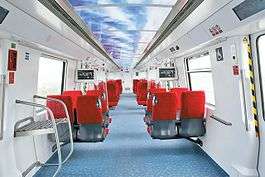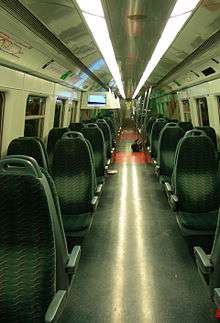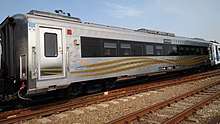First class travel
First class is the most luxurious and most expensive travel class of seats and service on a train, passenger ship, airplane, bus, or other system of transport.[1] Compared to business class and economy class, it offers the best service and most comfortable accommodation.

Aviation
The first-class section of a fixed-wing jet airliner is typically toward the front of the aircraft. Many airlines have removed first class altogether from their international flights, offering business class as their highest level of international service. First class passengers are usually allowed into lounges at airports while they wait for their flights.
Railways
While first-class travel accommodation is common in intercity public transport rail services, they have become increasingly prevalent for commuters' short-distance daily travel, especially in rapid transit contexts, rather than longer-distance regional rail.
Australia
Australia has internal rail operations in each of its states, excluding Tasmania, normally run by the State Government but in some cases is run by private operators. In each state, first class travel differs.
First-class travel on TrainLink comes in two forms. On Xplorer and XPT trains, first-class seating is offered which include an increased legroom and seating recline over economy-class seating. On some XPT trains, first-class sleeping compartments can also be found. On day services these accommodate three people per compartment, and by night they carry two people with bunk-style accommodation.
Queensland Rail offer first-class travel on many of their Traveltrain services, along with business class on their Tilt Train Services. Queensland Rail Traveltrain first class carriages provided private cabins in either roomette (single room) or twinette (double room) cabins.
First-class accommodation on V/Line is a 2x2 seating arrangement, with extra legroom and recline, only available on certain locomotive-hauled services.[2]
- Journey Beyond (New South Wales, Victoria, South Australia, Northern Territory and Western Australia)
This railway privately operates the tourist-oriented The Overland, Indian Pacific, and The Ghan services. The first class travel on these trains are branded as Platinum Service (on the Indian Pacific and The Ghan) with roomette, twinette and deluxe cabins; or Red Premium Service (on The Overland) with 2x1 seating, extra legroom, and more recline than the Red Service seating.
Canada
The Canadian (French: Le Canadien) train, operated by Via Rail, offers a Prestige class, comparable to first class. It includes room service, in-room entertainment, and a private washroom with shower.[3] The Québec City–Windsor corridor, also operated by Via Rail, offers a business class.
China

China Railway and its high-speed subsidiary offer First Class on its trains, slotting in between the standard "Second Class" and the premium "Business Class" tier. First Class consists of 2 seats on each side of the aisle, with adjustable, larger-than-normal seats, footrests, and access to sockets, toilets, and water dispensers.[4]
Aside from inter-city train services, Shenzhen Metro Line 11, which serves the regional airport, has become the first metro line in China to offer Business Class cars (making up two of the eight cars on each train). It has been reported that this service, costing three times the amount of a standard class ticket, has remained sparsely used despite overcrowding in the rest of the train.[5]
Germany

The various private and state-owned railways in Germany featured first-class, second-class and third-class amenities from the start. Beginning in Prussia in 1852, extremely austere fourth-class coaches were introduced. After nationalization (1920) and consolidation (Deutsche Reichsbahn-Gesellschaft, 1924), the fourth class was abandoned in 1928 in order to generate more revenue by forcing passengers to pay the higher prices for third-class tickets.
As those of most of the rest of Europe, the railways of East as well as West Germany moved to a two-class system in 1956. To this end, the first class was abandoned and the former second and third classes redesignated as the new first and second classes. Except for some regional and commuter train services (including some, but not all S-Bahn systems), which are second-class only, this distinction exists to this day.
The difference in amenities between the first and second class varies between train operators, services and lines. It generally translates to more legroom, tables and/or three-abreast instead of four-abreast seating for first-class passengers. On Deutsche Bahn's international and Sprinter ICE services, first-class passengers, unlike second-class passengers, receive a complimentary meal; on all ICE and InterCity services, passengers in first class are served the full selection of meals and refreshments at their seats, while second-class passengers can only obtain them in the dining car.
With some, primary local, services operated both by DB and other companies, there is no difference in seating between classes, with exception to the presence of armrests and tables (with ostensibly cleaner interiors in some instances) in first class. The rationale for providing first-class spaces on these services is mainly that due to the higher price, there are usually seats left in first class when all second-class seats are taken. As such, the justification of purchasing First Class on regional services, often for the average traveller, is more so dictated as offering a "better-odds" gamble of finding vacant seating availability on certain trains (esp. rush hour S-Bahn/regional services) rather than the availability of tangible frills in contrast to second class.
Hong Kong

A First Class compartment is available on each train serving the East Rail line (formerly KCR East Rail) in Hong Kong. Instead of longitudinal, stainless steel benches offered to standard-class passengers, the first-class compartments have comfier, individual padded seating with armrests. They are arranged in pairs and oriented transversely to the compartments.[6] Passengers are required to pay an extra "first class premium" (equaling to the standard adult fare of the same East Rail line journey) on top of the standard fare, and first-class compartments are regularly patrolled by ticket inspectors.[7]
The line originated as an intercity rail service, then known as the Kowloon-Canton Railway British Section, that formerly extended into Guangdong in Mainland China. Even after the line was electrified and modernized in the early 1980s and its trains were converted to provide high-capacity, metro-style service the following decade, the fourth compartment from the north end of each trainset retained its original seating layout as a First Class compartment. In 2007, the line became part of the MTR network, and it remains the only railway line in the region to offer a separate first-class service (though the Airport Express line provides a similar travel experience in all its carriages).
India
A number of suburban railways in India offer first-class travel, including:
- Hyderabad Multi-Modal Transport System
- Mumbai suburban railway
- Chennai suburban railway
Indonesia

The Indonesian Railway Company operates first-class services that are officially called Luxury class services. Luxury class cars currently in operation have two different designs: the first-generation Luxury cars have a 1-1 seating formation with a dominantly woody ambience; the second-generation Luxury cars have a 2-1 seating formation with a more modern ambience and a complimentary mini bar. Both generations have audio-video on demand (AVOD) displays and a relatively better comfort than Executive-class trains.
Japan
The term "First Class" was abolished on Japanese National Railways in May 1969, and was replaced by "Green cars". Green cars are identifiable by the green four-leaf clover logo at the doorways, and all seats in these cars are reserved. Usually they are in 1-2 configuration, with 2-2 configuration for Shinkansen trains, although more exclusive accommodations have also been introduced.[8] While "green cars" have traditionally been found on limited express services, in recent years, there has been a gradual trend to restore Green cars to longer-distance commuter lines in the Tokyo area, complete with "Green Attendants" who provide an at-seat refreshment service as well as checking tickets.[9] On overnight trains, premium accommodations are known as A cabins, which may be couchettes, private rooms or suites.
Nagoya Railroad (Meitetsu) refers to its first-class coaches as its "myu-ticket" (ミューチケット) service. These coaches are somewhat more comfortable than economy class and include assigned seating.
The Netherlands
Similarly to Germany, Dutch trains have had two classes since 1956. Currently, only trains running on the Merwedelingelijn and the line Zutphen–Oldenzaal have no first class seats. On two lines in Friesland there are no first class tickets, but the trains (which are also used on lines with first class tickets) do have first class seats. On most regional and local trains, the difference between second and first class is in only the padding of the seats, an additional armrest, decorative lighting or larger tables. In most cases, the first class in the trains is situated right behind the cabin, preventing others from walking through. On Intercity trains, first class has a 2+1 seating, as opposed to 2+2 in second class, can recline and feature a feet rest in coach seating. Most Intercity trains have only a few power sockets in first class, but this is due to the fact that providing a large number of power sockets would require significant modifications to the electrical system. All trains produced after 2015 have power and/or USB sockets in both classes.
Qatar
The Doha Metro, which began trial service in 2019, has a "Gold Class" section in one end car, similar to that of Dubai (below).[10]
Russia
The term "First Class" is not used as such by the Russian Railways, which has its own class system, but is commonly employed to translate the corresponding Russian term "SV" ("СВ" or "Спальный вагон", literally "Sleeping Car"). Note that while technically most cars in Russian long-distance trains are sleepers (i.e. berths rather than seats), the term is used only for the first-class cars. Such cars usually have 8 or 9 two-berth compartments with transversely mounted soft couches and a TV set, two toilets on different ends of the car, and a communal shower room (in 8-compartment cars). There is also a deluxe version of the SV car, usually dubbed "Premium", which features one-berth (or two-berth with foldable upper berth) compartments with a built in toilet/shower and better furnishing. This deluxe variant is sometimes informally referred to as "Myagky Vagon" (literally "Soft Car"), though this is a misnomer, as historically such designation indicated the intermediate between the SV and Coupe classes, long since discontinued, and referred to the better furnishing and softer padding of the berths as compared to the traditional Coupe class.
The service is usually the same in all classes on Russian Railways, the main difference being the increased personal space, reduced noise, and better isolation from unwanted contact with strangers, as well as better amenities; lower class cars may have a single shower per two couchette cars (54 passengers), while SV cars have one per 16 passengers, and in a Premium car each passenger has their own shower, an important consideration on lines such as the Trans-Siberian on which travel may last for up to a full week.
Spain
First-Class travel is not available on short-distance trains in Spain such as the Regionales or Cercanias services, but on long- and medium-distance trains such as the Altaria or Euromed services "Preferente" class, comparable to British first class, is available. This includes complimentary food and drinks (typically a welcome-aboard drink, including champagne, and drinks with the meal) as well as larger seats.
A further service is available on the high-speed AVE network. A club-class or preferente ticket allows access to lounges at certain stations. And onboard club-class service includes a large leather seat, power supply, à la carte food and unlimited complimentary bar service at your seat.
On all Spanish "Grandes Líneas" (long-haul) and Media Distancia (medium-haul) trains, video and music is available and accessed through complimentary headphones. Prices for first-class travel are not discounted other than for off-peak times of day and the price of a "preferente" ticket is normally only €30 - 40 more than economy, and club class on the AVE is normally only €40 more than "preferente" - significantly cheaper than most first-class fares in Britain.
United Kingdom

The existence and nature of different classes of passenger service on British trains has varied over time. From its inception, First, Second, and Third Class carriages were provided, alongside luxury Pullman coaches. Currently, most longer-distance services offer First Class and Standard Class, whilst most local and suburban services are single class – as are urban transit services such as the London Underground.
A First Class ticket offers access to dedicated sections of the train, nearly always featuring fewer but larger, and more comfortable seats, in a generally more spacious arrangement that provides more personal space, often a table and upgraded decor/carpeting, and in some cases additional amenities (such as power outlets for mobile phones or laptop computers and as well as upgraded lighting for each set of seats).
In addition to the dedicated seating, the current First Class rail experience may include access to a passenger lounge (at major departure and/or arrival stations) and additional on-board services, such as food and/or drinks service, complimentary newspapers, free onboard WiFi etc. Such on-board services vary widely; they can be distributed by train operating company, by route, by day of week (weekday or weekend), and by time of day. The most complete First Class experience is offered by long-distance train operators, such as Great Western Railway, Avanti West Coast, London North Eastern Railway, and Transport for Wales's Premier Service, especially on weekday morning and evening trains on high-volume routes, where it is targeted at business travelers.
On busy commuter services First Class seating is similar or identical to Standard Class. However its much higher cost ensures the First Class ticket holder a better chance of finding a seat. Some Train Operating Companies offer First Class fares that are often nearly double the fare of Standard class. On some services despite the existence of a First Class cabin, it is "declassified" indicating that any ticket holder may sit there, and first class tickets are usually not sold.
First Class service is offered on overnight Caledonian Sleeper and Night Riviera sleeper trains from London to Scotland and the West Country.
Eurostar international trains between Great Britain and continental Europe offer two distinct first-class services, which they call Business Premier and Standard Premier respectively, in addition to Standard Class. The on-board accommodation is the same; the difference is a greater flexibility, a shorter check-in time and more extensive catering (a full meal instead of a lighter snack) for the Business Premier service. Standard Premier was introduced on September 1, 2010; formerly, this service was called Leisure Select and also included full meal catering.
United States
From 1863, George Pullman introduced comfortable long-distance rail cars from, what was to become the Pullman Company, founded in 1867.[11]
Today, on Amtrak services, first-class travel is available on the Acela Express service, as well as long-distance services operated with Superliner or Viewliner stock. Passengers also have access to special waiting rooms at many cities and high-traffic stations. First class on the Acela Express service has wider seats than the standard business class (44 vs. 65 seats per carriage), in-seat electrical outlets, a carriage attendant, and complimentary meals and beverages.[12] On the long-distance services sleeping accommodation is provided, including Roomettes, Bedrooms, Bedroom Suites, and Accessible Bedrooms. Many rooms include a shower and toilet; for other rooms a toilet and/or shower is located nearby. Meals and other hotel-style services are also included in the price.[13]
South Korea
KTX (Korea Train eXpress), KTX-Sancheon (Type A, B), Saemaeul, Mugunghwa (available only in some routes) class trains operate First Class service. Called Teukshil (특실), First Class offers larger and comfortable seats. KTX and KTX-Sancheon First Class service includes complimentary mineral water, a headphone, water tissues, and a sleeping shade. Usually First Class tickets are about 50% more expensive than Economy Class tickets. First Class is located on Car 2, 3, 4 on the KTX trains, Car 3 on the KTX-Sancheon trains, and car 1 on the Mugunghwa and Saemaeul trains. ITX (Intercity Train eXpress) - Saemaeul trains do not have a First Class car.
Switzerland
The Swiss Federal Railways offers both first- and second-class travel on most of its long-distance services, but also on some local trains such as the S-Bahn network in Zürich.
United Arab Emirates
Part of one end car of each Dubai Metro train is designated as Gold Class, featuring individual seats, tray tables, and luggage compartments.[14]
Cruise ships and liners
Some benefits of first class on modern cruise ships include larger cabins, priority check-in, priority embarkation and disembarkation, priority meal-sitting selection, and, on premium lines, butler service.
References
- first class. (n.d.). The American Heritage Dictionary of the English Language, Fourth Edition. Retrieved October 19, 2007, from Dictionary.com website:
- "V/Line ~ First Class". www.vline.com.au. Retrieved 2012-03-30.
- "Classes". Via Rail. Retrieved 13 September 2014.
- "China Bullet Train First Class Seats". China Discovery. Retrieved 12 January 2020.
- Mu, Natalie (22 July 2016). "Few passengers pay triple for Shenzhen's business class subway cars". South China Morning Post. Retrieved 12 January 2020.
- Wong, Marcus (25 March 2011). "Travelling 'First Class' on the MTR". Checkerboard Hill. WordPress. Retrieved 12 January 2020.
- "Travelling First Class". MTR. Retrieved 12 January 2020.
- Rowthorn, Chris. "JR Trains: Green Cars Versus Ordinary Cars". Inside Kyoto. Retrieved 12 January 2020.
- "Figuring out the Green Car in Japan: JR Train Business Class Seats". Deep Japan. 30 March 2014. Retrieved 12 January 2020.
- "Doha Metro opened for preview service". RailTech. 13 May 2019. Retrieved 12 January 2020.
- George Mortimer Pullman, Appletons' Cyclopædia of American Biography
- "Amtrak – Plan – Onboard – Seating Accommodations – First Class Seat". www.amtrak.com. Retrieved 2012-03-30.
- "Amtrak – Plan – Onboard – Sleeping Accommodations". www.amtrak.com. Retrieved 2012-03-30.
- Zhang, Benjamin (3 February 2018). "I rode the Dubai Metro in a first-class cabin – and it was the best subway ride I've ever had". Business Insider. Insider Inc. Retrieved 12 January 2020.